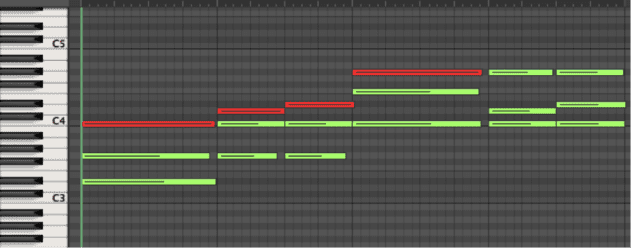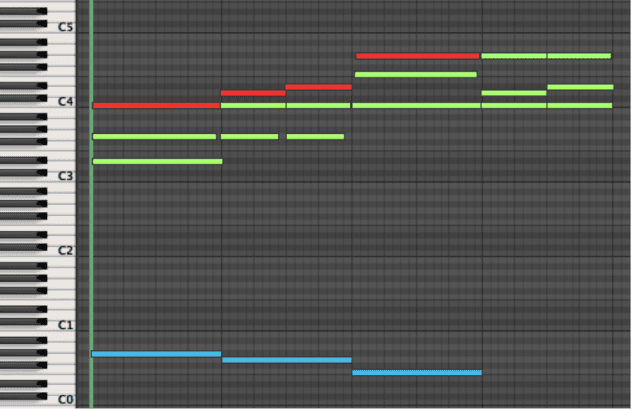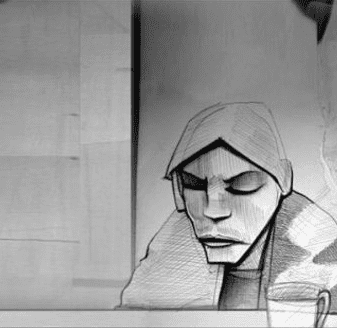In this week’s Passing Notes we look at a simple but powerful technique that can inject emotion and movement into a wide range of dance music.
Contrary motion describes opposite melodic trajectories taken by two musical lines. That is, one melody rises in pitch while, at the same time, another falls.
It’s a common technique employed by composers of classical music and it can be applied successfully to absolutely any style of dance music.
The most common use of contrary motion in electronic music is to create a contrast between a bassline and lead melody, but the same principle can be applied to any two melodic elements.
For a bit of historical context, let’s listen to one of the finest examples of contrary motion, taken from the third movement of Rachmaninov’s second symphony:
http://www.youtube.com/watch?v=v60qgwtOQCI
The progressions from 5:28 – 6:00, and 6:18 – 6:52 in particular contain two distinct melodic trajectories: the ascending violins and descending basses and low brass.
Although this example is probably more complex than anything we could slot into a typical dance track, it’s useful to see the potential this technique has in imparting emotion and direction in music.
Now, let’s look at a more contemporary example of the same technique in action: the string sample and bassline used by Burial in the track ‘Archangel’ from his 2007 album Untrue. (The sample is taken from Harry Gregson-Williams’ score for a cut scene in the video game Metal Gear Solid 2.)
http://www.youtube.com/watch?v=IlEkvbRmfrA
Here’s how the string sample sounds in the track, with a transcribed piano roll below.
Audio Player
It’s the ascending pattern of the top melody line we’re most interested in here. The notes are highlighted in red: C, D, Eb, and Ab. These are notes 1, 2, 3 and 6 of an ascending C minor scale, and because of this it would often seem natural for the bass to follow an ascending pattern starting on the ‘tonic’ or root note of the scale, in this case C.
Below, is how the sample would sound with a similarly ascending bassline of C, D, Eb, F.
It’s a nice enough progression, but it’s all a bit predictable.
Below we can see how the bassline used by Burial, highlighted in blue, moves down the C minor scale, starting on Ab, then G, then F, while the melody on top moves upwards.

And here’s how it sounds:
The result introduces an element of tension as the two melodies work against each other, creating a much more interesting result than the obvious ascending bassline. The use of contrary motion in ‘Archangel’ contributes hugely to its emotion and movement.
Contrary motion is a simple musical technique that’s frequently overlooked in dance music. However, as seen in ‘Archangel’, it is one that can be hugely effective.

05.07 PM
oliver this is an incredible article, very concise and well written
08.33 AM
Instantly thought of Julio Bashmore’s Au seve. Brilliantly used in that track IMO. Great Article.
12.45 PM
Great article. It’s to the point, but uses good examples to illustrate. I’ve really enjoyed all the Technique features thus far, keep ’em coming!
01.47 PM
incredible track and well written article.! Keep up the good work
02.57 AM
(y)
11.39 AM
What a great article! I got a question though:
“Below we can see how the bassline used by Burial, highlighted in blue, moves down the C minor scale, starting on Ab, then G, then F, while the melody on top moves upwards.”
I’m missing something here. Why are the notes chosen an A# etc.. What is their relation to the chord above them? They are not part of it, so how would I know which notes to choose for the bassline? I does not look like you have to try and see for yourself, because almost everything in music is explanatory and has a reason.
05.56 PM
Hey Niels, great point and one we’ll be looking at in more detail soon. As you say, almost everything in music can be explained in terms of theory and this is no different. However (for me at least!), writing any music has an element of experimentation to it and there are very few rules that are applicable to everything, especially where melody and harmony are concerned. Contrary motion between the bass and melody lines can just give your progressions that little bit more feeling and drive, so if your melody line goes up in pitch, try experimenting with a bassline that goes down in the same key, or vice versa.
As you also correctly point out, the Ab isn’t in the original chord of C minor. This note in the bass actually changes the resulting chord to an Ab major 7 (See the chord table in ‘Passing Notes – Deep House Chords’). Again, this is something we’ll look into in greater detail in a future Passing Notes.
Cheers
Oliver
06.04 AM
Hi Oliver,
Thanks for your reply. I should have seen it was a 7th in total and to correct myself, it was Ab not A#. I’ve been busy quita a long time now with the harmony thing. Anyway you guys are doing a great job, this is what music is all about, without tension, emotion and release, it means nothing to you. Whether it be trance, hiphop, funk or house music. Many seem to skip this part, it’s all about techniques and using samples and stuff. But you have to start here. Julio Bashmore sounds so simple but the technique doesn’t matter because he knows the rules of music. He touches you with only a few chords and a bassline.
Oliver, keep it up. I will continue to follow your site.
Cheers
Niels
11.19 PM
love this. great work and here’s to more.
09.08 PM
excellent stuff !
12.05 AM
wow great article. This site is a real gem.
08.38 AM
This exact technique (as mentioned above) is used in Julio Bashmore’s Au Seve to great effect (even if the track is getting a little tired at this point).
Superb article, thanks.
11.49 PM
This is probably THE most inciteful piece of information I’ve ever read.
08.46 PM
Great work! More of that!
06.41 AM
“I recently came across your web site and have been reading along. I thought I would leave my very first comment. Nice blog! I will keep visiting this website very frequently.”